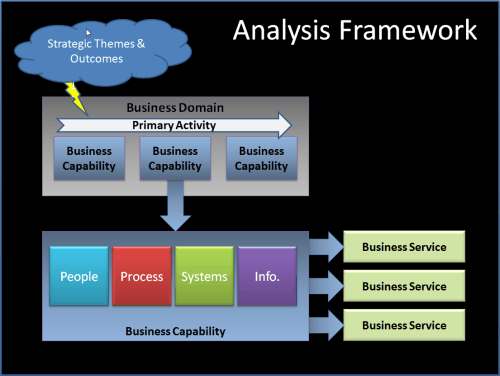Share this
Enterprise Analysis - using business architecture to clarify the muddle (Part 2)
by John Barris on 29 June 2011
This post continues from the post Enterprise Analysis - Using Business Architecture to Clarify the Muddle (Part 1).
The picture below shows how the high level view of the business connects with the elements that may be changed to improve the business performance. This view allows the analyst to connect the requirements for change with the business itself and present a context for the change that is required. It allows people to start talking about what they know - the business. One General Manager described this kind of view as lowering the barrier of participation…it encouraged the different stakeholders to engage in the project.

Business Architecture addresses the Business Analysis challenges
In the previous post I presented 4 challenges that Business Analysts face. Business architecture addresses these challenges by:
- Simplifying complexity - a high level composite view of the business allows us to more fully understand the nature of a change.
- Providing context – having a blueprint that shows the connections between goals, activities and capabilities enables analysts to provide context to any change that is planned.
- Clarifying scope – rather than stating what’s in and what’s out we are more focused on where in the business we draw the line.
- Allowing us to focus on the business change – we can focus on the amount of change rather than the number of project tasks.
Tips for using business architecture
Having applied business architecture on a number of Equinox consulting assignments, here are a couple of practical points for using business architecture:
- Keep it simple
- Involve others to lower the barrier to participation
- Focus on the business rather than the system
- Know when to stop
The feedback I received indicated that there is a great interest in this topic, and that it is time that Business Analysts should step into this discipline, as many are. I would like to acknowledge my colleagues Wayne Woodfield for allowing me to adjust and use some of his slides and Brendon Livingstone who helped me put this and the previous post together.
Share this
- Agile Development (84)
- Software Development (64)
- Scrum (39)
- Business Analysis (28)
- Agile (27)
- Application Lifecycle Management (26)
- Capability Development (20)
- Requirements (20)
- Solution Architecture (19)
- Lean Software Development (17)
- Digital Disruption (16)
- IT Project (15)
- Project Management (15)
- Coaching (14)
- DevOps (14)
- Equinox IT News (12)
- IT Professional (11)
- Knowledge Sharing (10)
- Strategic Planning (10)
- Agile Transformation (9)
- Digital Transformation (9)
- IT Governance (9)
- International Leaders (9)
- People (9)
- IT Consulting (8)
- AI (7)
- Cloud (7)
- MIT Sloan CISR (7)
- ✨ (7)
- Change Management (6)
- Azure DevOps (5)
- Innovation (5)
- Working from Home (5)
- Business Architecture (4)
- Continuous Integration (4)
- Enterprise Analysis (4)
- FinOps (4)
- Client Briefing Events (3)
- Cloud Value Optimisation (3)
- GitHub (3)
- IT Services (3)
- Business Rules (2)
- Data Visualisation (2)
- Java Development (2)
- Security (2)
- System Performance (2)
- Automation (1)
- Communities of Practice (1)
- Kanban (1)
- Lean Startup (1)
- Microsoft Azure (1)
- Satir Change Model (1)
- Testing (1)
- November 2025 (1)
- August 2025 (3)
- July 2025 (3)
- March 2025 (1)
- December 2024 (1)
- August 2024 (1)
- February 2024 (3)
- January 2024 (1)
- September 2023 (2)
- July 2023 (3)
- August 2022 (4)
- July 2021 (1)
- March 2021 (1)
- February 2021 (1)
- November 2020 (2)
- July 2020 (1)
- June 2020 (2)
- May 2020 (2)
- March 2020 (3)
- August 2019 (1)
- July 2019 (2)
- June 2019 (1)
- April 2019 (2)
- October 2018 (1)
- August 2018 (1)
- July 2018 (1)
- April 2018 (2)
- January 2018 (1)
- September 2017 (1)
- July 2017 (1)
- February 2017 (1)
- January 2017 (1)
- October 2016 (2)
- September 2016 (1)
- August 2016 (4)
- July 2016 (3)
- June 2016 (3)
- May 2016 (4)
- April 2016 (5)
- March 2016 (1)
- February 2016 (1)
- January 2016 (1)
- December 2015 (5)
- November 2015 (11)
- October 2015 (3)
- September 2015 (1)
- August 2015 (1)
- July 2015 (7)
- June 2015 (7)
- April 2015 (1)
- March 2015 (2)
- February 2015 (2)
- December 2014 (3)
- September 2014 (2)
- July 2014 (1)
- June 2014 (2)
- May 2014 (8)
- April 2014 (1)
- March 2014 (2)
- February 2014 (2)
- November 2013 (1)
- October 2013 (2)
- September 2013 (2)
- August 2013 (2)
- May 2013 (1)
- April 2013 (3)
- March 2013 (2)
- February 2013 (1)
- January 2013 (1)
- November 2012 (1)
- October 2012 (1)
- September 2012 (1)
- July 2012 (2)
- June 2012 (1)
- May 2012 (1)
- November 2011 (2)
- August 2011 (2)
- July 2011 (3)
- June 2011 (4)
- April 2011 (2)
- February 2011 (1)
- January 2011 (2)
- December 2010 (1)
- November 2010 (1)
- October 2010 (1)
- February 2010 (1)
- July 2009 (1)
- October 2008 (1)